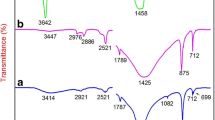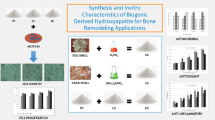Abstract
Hydroxyapatite (HA) is similar to the inorganic component of human bone and teeth. Because of its excellent biocompatibility, bioactivity, and osteoconductivity, HA is widely used as a biomedical material. However, its biodegradability is poor. Oyster shells are mainly composed of CaCO3 and other trace elements, such as Mg, Sr, K, and Na. As a raw material for synthesizing HA, oyster shells not only serve as biowaste for efficient utilization but also contain various trace elements that are beneficial to the growth of bone tissue; they can thus enhance the overall biological performance of the bioceramic. In this study, microrod HA bundles were successfully synthesized using microwave irradiation with the aid of ethylene diamine tetra-acetic acid disodium salt (Na2EDTA) as a chelating agent. The formation of microrod HA bundles was expected to promote the material’s biodegradability, and the bundles could have potential in the field of bone tissue repair. The optimal parameters for synthesis of microrod HA bundles were a Na2EDTA-to-oyster-shell-powder ratio of 2/2 and a microwave power of 700 W. The microrod HA bundles degraded more easily than did the irregular HA aggregates, indicating that the morphology of the microrod bundles resulted in a higher HA degradation rate. Bioactivity tests revealed that numerous spherical apatite particles formed on the surface of the microrod HA bundles, indicating that they had excellent bioactivity. Finally, the microrod HA bundles had high protein adsorption capability, which facilitates the control of cell attachment and proliferation and is thus beneficial to tissue regeneration.








Similar content being viewed by others
References
Panda, S., Biswas, C.K., Paul, S.: A comprehensive review on the preparation and application of calcium hydroxyapatite: a special focus on atomic doping methods for bone tissue engineering. Ceram. Int. (2021) in press
Rujitanapanich, S., Kumpapan, P., Wanjanoi, P.: Synthesis of hydroxyapatite from oyster shell via precipitation. Energy. Proc. 56, 112–117 (2014)
Ben-Arfa, B.A.E., Salvado, I.M.M., Ferreira, J.M.F., Pullar, R.C.: Novel route for rapid sol-gel synthesis of hydroxyapatite, avoiding ageing and using fast drying with a 50-fold to 200-fold reduction in process time. Mater. Sci. Eng. C 70, 796–804 (2017)
Sun, J., Zheng, X., et al.: Monodisperse selenium-substituted hydroxyapatite: controllable synthesis and biocompatibility. Mater. Sci. Eng. C 73, 596–602 (2017)
Shi, H., Zhou, Z., Li, W., Fan, Y., Li, Z., Wei, J.: Hydroxyapatite based materials for bone tissue engineering: A brief and comprehensive introduction. Curr. Comput.-Aided Drug Des. 11, 149 (2021)
Wu, S.C., Hsu, H.C., Hsu, S.K., Chang, Y.C., Ho, W.F.: Effects of heat treatment on the synthesis of hydroxyapatite from eggshell powders. Ceram. Int. 41, 10718–10724 (2015)
Wu, S.C., Tsou, H.K., et al.: A hydrothermal synthesis of eggshell and fruit waste extract to produce nanosized hydroxyapatite. Ceram. Int. 39, 8183–8188 (2013)
Wu, S.C., Hsu, H.C., Hsu, S.K., Tseng, C.P., Ho, W.F.: Preparation and characterization of hydroxyapatite synthesized from oyster shell powders. Adv. Powder Technol. 28, 1154–1158 (2017)
Wu, S.C., Hsu, H.C., Wu, Y.N., Ho, W.F.: Hydroxyapatite synthesized from oyster shell powders by ball milling and heat treatment. Mater. Charact. 62, 1180–1187 (2011)
Karacan, I., Cox, N., et al.: The synthesis of hydroxyapatite from artificially grown Red Sea hydrozoan coral for antimicrobacterial drug delivery system applications. J. Aust. Ceram. Soc. 57, 399–407 (2021)
Ha, L.V., Mai, D.N.T., Cao, H.T.: Fabrication of nano-or micro-powder for hydroxyapatite particles derived from bovine bone. Sci. Technol. Dev. J. 24, 875–883 (2021)
Chai, Y., Tagaya, M.: Simple preparation of hydroxyapatite derived from fish scales. Mater. Lett. 222, 156–159 (2018)
Zhou, H., Yang, M., et al.: Preparation of Chinese mystery snail shells derived hydroxyapatite with different morphology using condensed phosphate sources. Ceram. Int. 42, 16671–16676 (2016)
Hoppe, A., Guldal, N.S., Boccaccini, A.R.: A review of the biological response to ionic dissolution products from bioactive glasses and glass-ceramics. Biomaterials 32, 2757–2774 (2011)
Tucker, K.L., Hannan, M.T., et al.: Potassium, magnesium, and fruit and vegetable intakes are associated with greater bone mineral density in elderly men and women. Am. J. Clin. Nutr. 69, 727–736 (1999)
Yokota, T., Miki, T., et al.: Fabrication and biological evaluation of hydroxyapatite ceramics including bone minerals. J. Ceram. Soc. Jpn. 126, 99–108 (2018)
Sadat-Shojai, M., Khorasani, M.T., Dinpanah-Khoshdargi, E., Jamshidi, A.: Synthesis methods for nanosized hydroxyapatite with diverse structures. Acta Biomater. 9, 7591–7621 (2013)
Pramanik, S., Agarwal, A.K., Rai, K., Garg, A.: Development of high strength hydroxyapatite by solid-state-sintering process. Ceram. Int. 33, 419–426 (2007)
Zakhireh, S., Adibkia, K., Beygi-Khosrowshahi, Y., Barzegar-Jalali, M.: Osteogenesis promotion of selenium-doped hydroxyapatite for application as bone scaffold. Biol. Trace Elem. Res. 199, 1802–1811 (2021)
Nunez, D., Elgueta, E., Varaprasad, K., Oyarzun, P.: Hydroxyapatite nanocrystals synthesized from calcium rich bio-wastes. Mater. Lett. 230, 64–68 (2018)
Daryan, S.H., Javadpour, J., Khavandi, A., Erfan, M.: Morphological evolution on the surface of hydrothermally synthesized hydroxyapatite microspheres in the presence of EDTMP. Ceram. Int. 44, 19743–19750 (2018)
Xiao, W., Gao, H., Qu, M., Liu, X., Zhang, J., Li, H.: Rapid microwave synthesis of hydroxyapatite phosphate microspheres with hierarchical porous structure. Ceram. Int. 44, 6144–6151 (2018)
Kumar, G.S., Thamizhavel, A., Girija, E.: Microwave conversion of eggshells into flower-like hydroxyapatite nanostructure for biomedical applications. Mater. Lett. 76, 198–200 (2012)
Goh, K.W., Wong, Y.H., et al.: Effect of pH on the properties of eggshell-derived hydroxyapatite bioceramic synthesized by wet chemical method assisted by microwave irradiation. Ceram. Int. 47, 8879–8887 (2021)
Bakan, F., Laçin, O., Sarac, H.: A novel low temperature sol–gel synthesis process for thermally stable nano crystalline hydroxyapatite. Powder Technol. 233, 295–302 (2013)
Hannink, G., Arts, J.C.: Bioresorbability, porosity and mechanical strength of bone substitutes: what is optimal for bone regeneration? Injury 42, S22–S25 (2011)
Khiri, M.Z.A., Matori, K.A., et al.: Crystallization behavior of low-cost biphasic hydroxyapatite/β-tricalcium phosphate ceramic at high sintering temperatures derived from high potential calcium waste sources. Results Phys. 12, 638–644 (2019)
Lin, K., Wu, C., Chang, J.: Advances in synthesis of calcium phosphate crystals with controlled size and shape. Acta Biomater. 10, 4071–4102 (2014)
Lai, W., Chen, C., Ren, X., Lee, I.-S., Jiang, G., Kong, X.: Hydrothermal fabrication of porous hollow hydroxyapatite microspheres for a drug delivery system. Mater. Sci. Eng. C 62, 166–172 (2016)
Sánchez-Campos, D., Reyes Valderrama, M.I., et al.: Modulated monoclinic hydroxyapatite: the effect of pH in the microwave assisted method. Minerals 11, 314 (2021)
Arce, H., Montero, M.L., Sáenz, A., Castaño, V.M.: Effect of pH and temperature on the formation of hydroxyapatite at low temperatures by decomposition of a Ca-EDTA complex. Polyhedron 23, 1897–1901 (2004)
Salarian, M., Solati-Hashjin, M., Shafiei, S.S., Salarian, R., Nemati, Z.A.: Template-directed hydrothermal synthesis of dandelion-like hydroxyapatite in the presence of cetyltrimethylammonium bromide and polyethylene glycol. Ceram. Int. 35, 2563–2569 (2009)
Chen, M., Jiang, D., Li, D., Zhu, J., Li, G., Xie, J.: Controllable synthesis of fluorapatite nanocrystals with various morphologies: effects of pH value and chelating reagent. J. Alloys Compd. 485, 396–401 (2009)
Predoi, S.A., Ciobanu, C.S., et al.: Preparation of porous hydroxyapatite using cetyl trimethyl ammonium bromide as surfactant for the removal of lead ions from aquatic solutions. Polymers 13, 1617 (2021)
Zuo, G., Wei, et al.: Morphology controlled synthesis of nano-hydroxyapatite using polyethylene glycol as a template. J. Alloys Compd. 692, 693–697 (2017)
Fathi, M.H., Hanifi, A., Mortazavi, V.: Preparation and bioactivity evaluation of bone-like hydroxyapatite nanopowder. J. Mater. Process. Technol. 202, 536–542 (2008)
Kokubo, T., Takadama, H.: How useful is SBF in predicting in vivo bone bioactivity? Biomaterials 27, 2907–2915 (2006)
Šupová, M.: Substituted hydroxyapatites for biomedical applications: a review. Ceram. Int. 41, 9203–9231 (2015)
Kannan, S., Rocha, J.H.G., Ferreira, J.M.F.: Synthesis and thermal stability of sodium, magnesium co-substituted hydroxyapatites. J. Mater. Chem. 16, 286–291 (2006)
Safarzadeh, M., Ramesh, S., et al.: Effect of multi-ions doping on the properties of carbonated hydroxyapatite bioceramic. Ceram. Int. 45, 3473–3477 (2019)
Kaygili, O., Ates, T., Keser, S., Keser, S., Al-Ghamdi, A.A., Yakuphanoglu, F.: Controlling of dielectrical properties of hydroxyapatite by ethylenediamine tetraacetic acid (EDTA) for bone healing applications. Spectrochim. Acta A 129, 268–273 (2014)
Macha, I.J., Ben-Nissan, B., et al.: Biocompatibility of a new biodegradable polymer-hydroxyapatite composite for biomedical applications. J. Drug Deliv. Sci. Technol. 38, 72–77 (2017)
Kumar, G.S., Thamizhavel, A., Yokogawa, Y., Kalkura, S.N., Girija, E.K.: Synthesis, characterization and in vitro studies of zinc and carbonate co-substituted nano-hydroxyapatite for biomedical applications. Mater. Chem. Phys. 134, 1127–1135 (2012)
Zhu, R., Yu, R., Yao, J., Wang, D., Ke, J.: Morphology control of hydroxyapatite through hydrothermal process. J. Alloys Compd. 457, 555–559 (2008)
Kee, C.C., Ismail, H., Ahmad-Fauzi, M.N.: Effect of synthesis technique and carbonate content on the crystallinity and morphology of carbonated hydroxyapatite. J. Mater. Sci. Technol. 29, 761–764 (2013)
Li, Y., Wang, Y., et al.: Controllable synthesis of biomimetic hydroxyapatite nanorods with high osteogenic bioactivity. ACS Biomater. Sci. Eng. 6, 320–328 (2020)
Nga, N.K., Chau, N.T.T., Viet, P.H.: Facile synthesis of hydroxyapatite nanoparticles mimicking biological apatite from eggshells for bone-tissue engineering. Colloids Surf. B 172, 769–778 (2018)
Huang, B., Lou, Y., et al.: Molecular dynamics simulations of adsorption and desorption of bone morphogenetic protein-2 on textured hydroxyapatite surfaces. Acta Biomater. 80, 121–130 (2018)
Acknowledgements
The authors acknowledge the partial financial support of Ministry ofScience and Technology of Taiwan (MOST 108-2813-C-390-014-E).
Author information
Authors and Affiliations
Corresponding author
Additional information
Publisher's note
Springer Nature remains neutral with regard to jurisdictional claims in published maps and institutional affiliations.
Shih-Ching Wu and Yu-Lin Kao contributed equally to this work.
Rights and permissions
About this article
Cite this article
Wu, SC., Kao, YL., Lu, YC. et al. Preparation and characterization of microrod hydroxyapatite bundles obtained from oyster shells through microwave irradiation. J Aust Ceram Soc 57, 1541–1551 (2021). https://doi.org/10.1007/s41779-021-00657-3
Received:
Revised:
Accepted:
Published:
Issue Date:
DOI: https://doi.org/10.1007/s41779-021-00657-3




